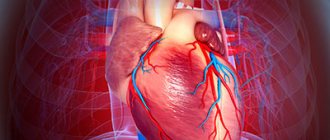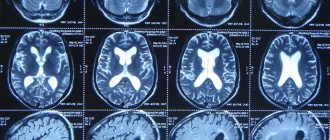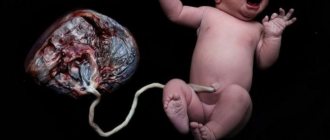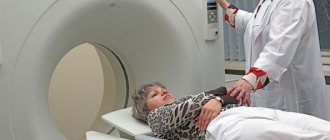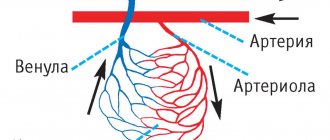Tremors in the body and palpitations occur in a person for a reason. In this case, there are many options, but one thing is clear - the body is already tired, both physically and mentally, and the nervous system is simply “at the limit.”
It happens that everything seems to be fine, but then a sharp trembling begins inside the body, rapid heartbeat, and poor health. And this is regardless of the weather, the temperature in the house, body temperature - everything happens suddenly.
This feeling of internal tremor is not so scary, and not so worrying, but this is the first “bell” of the body - something is wrong. During this state, you want to quickly take cover and warm up, but everything is useless, you are still freezing, and your pulse is about to jump out.
What is the reason for this condition?
Causes of palpitations and trembling
These manifestations are one of the common reasons why patients see a cardiologist, therapist, neurologist, or endocrinologist.
What could it be?
This condition is fueled by periodic loss of pulse, too fast heart rate, weakness, and goosebumps.
Factors influencing this manifestation are different and are not always related to the work of the heart muscle:
- Cardiac conduction disorder
- Secondary myocardial contractions,
- Development of arrhythmia,
- Heart disease,
- Heart attack, etc.
But there are also a large number of reasons not related to the functioning of the heart:
- Incorrect functioning of the gastrointestinal tract. And since the organs are directly related to the heart muscle, frequent pulsation is also closely related to this.
- When the vagus nerve appears, a certain disruption occurs in the functioning of digestion, which gives a signal of disturbances. It is precisely this symptom that can cause minor trembling. Patients may also feel a little nervous during a gastroscopy.
- Shaking in the body is often provoked by an incorrect approach to any of the therapies, when medication is taken uncontrollably.
- When a large amount of nicotine enters the body, frequent pulsation and trembling in the arms and legs occur.
- With the development of diseases associated with the endocrine system, these deviations from the normal functioning of the heart can also be observed. This is due to incomplete production of Thyroxin, TRIIODOTHYRONINE.
- Alcohol, like no other, can cause a person’s internal tremors.
- Rheochromocytoma is the name of an oncological process in the adrenal glands, the symptoms of which are a strong heartbeat.
- With constant abuse of drinks with large amounts of caffeine, internal shaking in the body and headaches appear.
- As for the female gender, this kind of symptoms can appear after the onset of menopause.
- During surges in body temperature: ARVI, bronchitis, inflammatory processes, tremors are also observed in the heart area, which is directly related to the feverish state of the patient.
When it comes to problems with the endocrine system, it should be noted that trembling occurs only in the morning, and towards lunch everything returns to normal.
What is cardiac arrhythmia
The normal heart rate (i.e., the number of heartbeats per minute) depends primarily on the person’s age:
- at 30-40 years old, the normal frequency is 75-80 beats;
- at 40-60 years old 75-90 beats;
- at 60-80 years old 80-90 beats per minute.
Arrhythmia is a heart rhythm disorder that can manifest itself in different forms:
- change in heart rate;
- rhythm disturbance (above or below normal);
- disturbances in the sequence of contractions of the heart muscle.
Simply put, arrhythmia is any deviation of the heart rhythm from the average norm. In most cases, it speaks of disturbances in the functioning of the cardiovascular system.
Pathologies causing symptoms
When a person shakes inside the body, this is primarily an indicator that there is a violation of thermoregulation. And this is the first sign of problems with the endocrine system (Graves disease, diffuse goiter), as well as various types of fever.
During an injection for diabetes mellitus, slight trembling of the body may also occur.
A strong heart rhythm may also indicate that there was severe blood loss, anaphylactic or painful shock, collapse, anemia, hypoxia.
Main causes of arrhythmia
There can be many factors leading to the development of this pathology. Moreover, even if a person leads a healthy lifestyle and regularly plays sports, he may experience rare attacks of heart palpitations. The most common reasons are lifestyle factors, including bad habits:
- unhealthy diet (fatty foods);
- as a consequence - obesity;
- excessive alcohol consumption;
- smoking;
- lack of sleep, sleep disturbances;
- uncontrolled use of certain types of medications;
- too intense physical activity.
Arrhythmia may also be associated with other reasons:
- pathologies and abnormalities of the cardiovascular system;
- Congenital heart defect;
- genetic factor (congenital anomalies, predisposition);
- diabetes;
- disorders of the thyroid gland;
- sinus node diseases;
- heart failure;
- vegetative-vascular dystonia.
First aid
At the first manifestations of severe trembling, rapid heartbeat, weakness, you should immediately stop any exercise and go out into the fresh air (if you are in a stuffy room).
If you are asked for help in this condition, then the first stage should be to put the person with his back on a flat surface (floor, table), and give as much opportunity as possible to breathe in fresh air: open the window, unbutton his shirt, take off his tie. If you observe a person’s face becoming paler, then you should raise your legs a little higher than your body, as these are the first signs of fainting or stroke.
If a person is shaking from heart disease, then first of all you need to give Valerian and Motherwort.
Treatment
Help before diagnosis
If the cause of severe chills without fever is general hypothermia, you need to take the person to a warm room as quickly as possible, give him hot tea, cover him with several blankets or prepare a warm bath. Chilling caused by stress goes away on its own after the traumatic situation is resolved; tea with mint, which has a sedative effect, also helps to calm down. If chills develop for no apparent reason and are combined with a deterioration in health or general malaise, you should consult a doctor.
Hot tea will help you warm up when you have a chill.
Conservative therapy
Medical tactics depend on the etiological factor of the discomfort and the general condition of the patient. If you feel chills without an increase in temperature, etiotropic treatment is indicated to eliminate the underlying disease. If symptoms occur against the background of a high fever, you first need to lower the temperature. For colds, physiotherapeutic treatment methods are successfully used: gargling, nasal rinsing, electrophoresis and local electromagnetic effects. The drug therapy regimen may include:
- Antipyretics
. Medicines with an antipyretic effect (usually paracetamol) are prescribed for fever over 38.5 °C. Children's temperature is reduced starting from 38 degrees. Aspirin should not be taken due to its toxic effect on the liver and red blood cells. - Antispasmodics
. The drugs are especially effective for chills without fever. They relax the smooth muscles of blood vessels, which helps to expand their lumen and normalize blood flow. Medicines can be used in the first stage of fever. - Sedatives
. Mild herbal remedies help normalize vegetative reactions and the tone of superficial vessels. The drugs are indicated for VSD, stress and chronic fatigue syndrome. Sometimes the treatment regimen is supplemented with “daytime” tranquilizers. - Hormonal agents
. If the appearance of chills without fever is due to fluctuations in female sex hormones during menopause, replacement therapy with estrogen drugs is recommended. For hypothyroidism, take levothyroxine. - Non-steroidal anti-inflammatory drugs
. If chills occur without fever, but are accompanied by signs of inflammation, NSAIDs are indicated. The drugs block the synthesis of specific mediators and cytokines. To consolidate the results, they are used in long courses.
Reasons to visit a doctor soon
The help of specialists will be required immediately in the following cases:
- If this state of the body has returned to normal (pulse jumps, frequent trembling, dizziness) - the causes of ischemic heart disease, arrhythmia, WPW syndrome.
- Severe pain in the chest, constant fear of death.
- Frequent general trembling after injections for diabetes mellitus.
- At temperatures above 38.2 °C.
- Blood pressure is above 130/70 mm. rt. Art.
- Frequent muscle pain, shaking hands.
Remember! These symptoms require immediate medical attention!
Symptoms of cardiac arrhythmia
The main symptoms of the pathology include the following:
- general weakness, appears suddenly;
- feeling of a strong heartbeat (“pounding” in the chest);
- sudden dizziness;
- headache of varying strength;
- attack of shortness of breath;
- chest pain of a compressive nature;
- in rare cases - episodic or regular loss of consciousness.
Some of the symptoms described are not specific. For example, patients often attribute headaches to psychological stress, and chest pain to severe physical exertion. Therefore, even if such signs rarely appear, it is better to consult a doctor for advice. Otherwise, the pathology can become irreversible, even leading to death, for example, due to myocardial infarction.
It is recommended to undergo diagnostics if at least one of the described deviations is present:
- insomnia;
- shortness of breath at night (a person wakes up in this state);
- noticeable, prolonged deterioration in general condition;
- frequent headaches;
- tremor (arms and/or legs shaking).
What is the diagnosis?
At the first manifestation of the above symptoms, you should first contact a therapist, after which you will be referred to the required specialist. Since different symptoms require referral to different doctors:
- With neurosis, trembling in the body and rapid heartbeat are different from other diseases - neurologist,
- Chills with VSD are a completely different picture, you will be referred to a cardiologist,
- Problems with the thyroid gland (other symptoms, there may be discomfort at the site of goiter formation) - endocrinologist, etc.
The main stage in the diagnostic process is taking tests (urine, blood), after which secondary types of examination of the heart muscle and vascular system follow:
- Electrocardiography (ECG),
- Ultrasound examinations (ultrasound),
- rheoencephalography (REG),
A brain examination may also be prescribed:
- echoencephalography (EchoEG),
- Electroencephalography (EEG),
- magnetic resonance imaging (MRI).
When investigating the causes of problems with the endocrine system, you should take tests for blood sugar levels, the level of insulin in the blood, and hormonal levels.
If there is a suspicion of heart disease, a study in the form of a CMS, an ECG recording per day, is used.
With a normal level of iodized and adrenal derivatives, with normal insulin and no untimely intake of antibiotics into the body, it allows you to immediately remove problems with the thyroid gland from the list.
Treatment for vegetative-vascular dystonia
During the development of vegetative-vascular dystonia in a person, treatment can be significantly inexpensive and not complicated:
- tea, tinctures, herbal decoctions (chamomile, calendula, ginseng, lemongrass, lure, immortelle leaves, valerian, etc.). These types of herbs will help normalize the nervous system, and a person will be able to normalize sleep at night,
- sedatives to improve heart function, as well as to relieve severe chills,
- preventive conversations with psychologists, neurologists,
- getting rid of life stress, tension, anxiety, depression (you can take a vacation, take salt baths, inhale the pores of beneficial herbs).
Something to remember! Any of the above methods must be agreed upon with a cardiologist and therapist, and in case of progression, placement in hospital treatment is possible
.
Causes of chills
Hypothermia
Chills without fever most often occur under the influence of an external cause - during the cold season or when clothing does not match the weather. The symptoms increase gradually: first, a person feels cold and a desire to warm up, then a downward trembling of small muscles begins - from the masticatory muscles and shoulder girdle to the muscle groups of the lower extremities. The skin turns pale. Short-term symptoms of chills are observed when a cold wind blows. The symptoms disappear on their own after warming up. Severe hypothermia requires medical attention.
Stress
During emotional stress, adrenaline is released in excess, which causes spasm of skin vessels and muscle tremors. A short-term feeling of muscle tension and trembling, combined with a feeling of extreme cold and increased sweating, is noted with fright and fear. In women, such attacks of chills of a psychogenic cause without fever are more common, which is due to the lability of the nervous system. Unpleasant symptoms disappear after normalization of the emotional state. If the signs bother you often, or even more so constantly, you should visit a doctor.
The influence of sex hormones in women
Menopause and menopause are the most common reasons why chills occur in females. The presence of the symptom is due to sudden changes in the levels of estrogen and progesterone, which disrupt the functioning of the nervous and cardiovascular systems. Patients report alternating periods of coldness and trembling in the body with hot flashes and redness of the face. Chills without fever in women are observed in the premenstrual period and on the first day of menstruation, which is associated with fluctuations in estrogen and blood loss.
The disorder worries pregnant women starting from the first trimester, when the secretion of sex hormones changes and the synthesis of tropic hormones in the anterior pituitary gland increases. Symptoms of chills appear at any time of the day, last a short time and do not significantly affect general well-being. In the second and third trimesters, the frequency of discomfort decreases. If prolonged severe chills develop, the general condition persistently worsens, urgent medical attention is needed.
Fever
Muscle tremors and a strong feeling of cold are observed in the first period of fever (with a cold, acute respiratory viral infection or non-infectious pathology), when the body temperature is just beginning to rise. The symptom is associated with centralization of blood circulation and spasm of peripheral vessels. Chills always develop at fever; the severity of the disorder depends on the speed of onset of fever and the cause of the symptoms. A person feels a sharp cold, he begins to shake, while the skin turns pale, the area of the nasolabial triangle becomes cyanotic (cyanotic).
Chills are accompanied by headache, severe weakness, and malaise. To keep warm, patients cover themselves with several blankets. When the temperature reaches its maximum, which indicates the transition of the fever into the second period, the feeling of cold and trembling disappear, the skin becomes bright pink. Manifestations of chills more often occur in adults, since in children the temperature often rises sharply without a prodromal period. Chilling is sometimes possible with a rapid (critical) decrease in temperature to normal levels.
Chronic inflammation
Frequent causes of chills at night are sluggish infectious or somatic inflammatory diseases. The development of the disorder is caused by chronic intoxication of the body, changes in the functioning of the autonomic nervous system. In men, the main cause of chills without fever is tuberculosis of the lungs or lymph nodes. With this infection, patients wake up in the middle of the night from malaise and feeling cold, and take another blanket to keep warm. Increased sweating and pronounced pallor of the skin are also characteristic. Other reasons for chills include:
- Autoimmune diseases
: rheumatoid arthritis, vasculitis, Hashimoto's thyroiditis. - Damage to internal organs
: chronic pyelonephritis, liver pathology.
Purulent processes
Purulent inflammation of any localization causes sharp, shaking chills, when a person shakes almost continuously, the skin becomes pale in color, and a marble pattern is formed on the distal parts of the extremities due to insufficient filling of the blood vessels and a decrease in blood pressure. Symptoms appear against the background of hectic or constant high fever; profuse sweats are typical as a consequence of massive intoxication of the body. The most common purulent causes of chills:
- Skin lesions
: panaritium, numerous boils and carbuncles, suppuration of wounds. - Pathologies of internal organs
: intestinal and liver abscess, pleural empyema, purulent cholecystitis and cholangitis. - Pylephlebitis.
- Gynecological diseases
: purulent mastitis, pyosalpinx and pyometra.
Vegetovascular dystonia
Violation of the coordinated work of the sympathetic and parasympathetic components of autonomic regulation, as the cause of the appearance of chills without fever, is noted quite often, especially in young people against the background of excitement and emotional turmoil. The symptom is caused by a narrowing of the lumen of peripheral vessels and a decrease in blood flow in the skin, which is perceived by the body as severe cold. Therefore, with VSD, the main symptoms of chills occur: slight muscle tremors, especially in the face and shoulder girdle - teeth begin to “chatter”, the skin turns pale and becomes covered with characteristic pimples.
Endocrine disorders
Common causes of chills without fever, which are more typical for women, are thyroid dysfunction. The organ secretes the hormone thyroxine, which is responsible for thermoregulation: with its deficiency, the basal metabolism slows down and body temperature decreases. The body reacts to such changes with contractile thermogenesis - generalized trembling of all muscle groups. The skin looks very pale and dry and feels cold to the touch. The sudden appearance of chills and excessive sweating are the first signs of hypoglycemia in diabetes mellitus.
Rare causes
- Systemic allergic reactions
: Quincke's edema, anaphylactic shock, allergic alveolitis in children. - Raynaud's disease and syndrome
. - Blood loss
: massive external bleeding, hemorrhages into organs and natural body cavities. - Psychogenic factors
: panic attacks, depressive states. - Neurological pathology
: amyotrophic lateral sclerosis, temporal lobe epilepsy. - Chronic fatigue syndrome.
- Iatrogenic causes
: post-transfusion reactions, complications of kidney transplantation.

